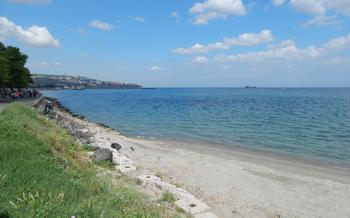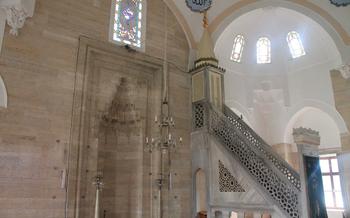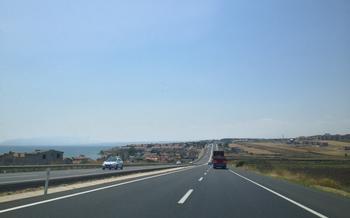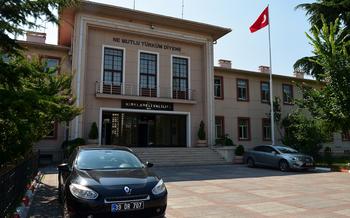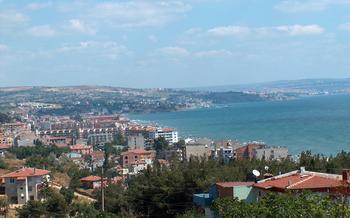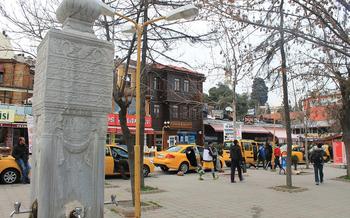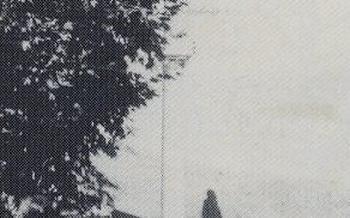
Tekirdağ Archaeology and Ethnography Museum
- About Tekirdağ
- Exploring the Tekirdağ Archaeology and Ethnography Museum
- Navigating the Museum's Exhibits
- Unveiling Tekirdağ's Rich History:
- Cultural Insights through Ethnographic Displays:
- Interactive Learning Experiences
- Mesmerizing Archaeological Treasures
- Highlight Exhibits Not to Miss:
- Uncovering the Stories of the Past
- Educational Programs and Workshops
- Accessibility and Facilities
- Preserving Cultural Heritage
- Community Engagement and Outreach
- Insider Tip: Tekirdağ Museum Week
About Tekirdağ
Tekirdağ, a city in northwestern Turkey, boasts a rich history dating back to ancient times. Strategically located on the Marmara Sea coast, Tekirdağ has been a melting pot of cultures, influenced by various civilizations throughout the centuries. From the Thracians to the Byzantines, the Seljuks to the Ottomans, each era has left its mark on the city's cultural tapestry.
Tekirdağ's geographical position has made it a vital trade and transportation hub. Its proximity to Istanbul, the former capital of the Ottoman Empire, further enhanced its significance. The city is renowned for its fertile agricultural lands, producing an abundance of grapes used to create the region's famous wines.
Culturally, Tekirdağ is a vibrant blend of Turkish traditions and influences from neighboring regions. The city's cuisine reflects this diversity, offering a tantalizing array of flavors. Must-try local dishes include Tekirdağ köftesi (meatballs), balık ekmek (fish sandwich), and Tekirdağ şarapları (wines).
Exploring the Tekirdağ Archaeology and Ethnography Museum
Established in 1967, the Tekirdağ Archaeology and Ethnography Museum stands as a testament to the region's rich cultural heritage. Housed in a beautifully restored Ottoman-era building, the museum boasts an impressive collection of artifacts and exhibits that narrate the story of Tekirdağ from ancient times to the present day.
The architectural style of the museum itself is a sight to behold, with its elegant stone facade and intricate carvings reflecting the grandeur of Ottoman architecture. Inside, the museum is designed to provide a comprehensive and immersive experience for visitors. Thematic sections and galleries guide visitors through various periods of Tekirdağ's history, showcasing a diverse range of artifacts from prehistoric tools to Ottoman-era manuscripts.
As a cultural hub, the museum plays a pivotal role in preserving and promoting the region's cultural heritage. It hosts a variety of educational programs, workshops, and exhibitions that engage visitors of all ages. Guided tours and audio guides are available to provide deeper insights into the exhibits and the stories they hold.
Navigating the Museum's Exhibits
The Tekirdağ Archaeology and Ethnography Museum offers a well-organized and comprehensive layout, allowing visitors to seamlessly navigate through its diverse exhibits. The museum's galleries are thematically arranged, each dedicated to a specific period or aspect of Tekirdağ's rich history and culture.
Upon entering the museum, visitors are greeted by a chronological display of artifacts from prehistoric times to the present day. Interactive displays and multimedia presentations enhance the experience, providing deeper insights into the stories behind the objects. Guided tours are available for a more in-depth exploration, with knowledgeable guides sharing fascinating anecdotes and historical context.
Audio guides are also available for self-guided tours, allowing visitors to explore at their own pace and delve into specific topics of interest. The museum's layout ensures a smooth flow of traffic, preventing overcrowding and creating a comfortable environment for visitors to immerse themselves in the exhibits.
Unveiling Tekirdağ's Rich History:
The Tekirdağ Archaeology and Ethnography Museum offers a captivating journey through the region's rich and diverse history. From the earliest traces of human presence in prehistoric times, the museum showcases a remarkable collection of artifacts that reveal the development of civilizations in Tekirdağ. Discoveries from ancient civilizations, such as the Thracians, Greeks, and Romans, provide glimpses into their cultural practices, artistic expressions, and technological advancements. The museum also houses an impressive collection of Ottoman-era relics and artifacts, highlighting the region's role in this significant period of Turkish history. These exhibits offer insights into the architectural, artistic, and cultural achievements of the Ottoman Empire, leaving visitors with a deeper understanding of Tekirdağ's multifaceted past and its contributions to the broader tapestry of Anatolian history.
Cultural Insights through Ethnographic Displays:
Delve into the rich cultural tapestry of Tekirdağ through the museum's ethnographic exhibits. Immerse yourself in the vibrant world of traditional costumes, each piece showcasing the intricate craftsmanship and artistry of the region. Discover the stories behind household items and tools, revealing the daily lives and practices of the local people. Marvel at the beauty of folk art and handicrafts, from vibrant carpets to delicate pottery, gaining insights into the local aesthetic and cultural influences. These displays offer a glimpse into the customs and traditions that have shaped Tekirdağ's cultural identity, providing a deeper understanding of the region's rich heritage.
Interactive Learning Experiences
The Tekirdağ Archaeology and Ethnography Museum offers a range of interactive learning experiences designed to engage visitors of all ages, particularly children. Hands-on activities allow young minds to explore history and culture in a tactile and memorable way. Educational programs and workshops delve deeper into specific topics, providing hands-on experiences and the opportunity to learn from experts in the field.
Virtual reality and augmented reality exhibits transport visitors to different time periods and environments, creating a truly immersive experience. Gamified learning experiences, such as interactive quizzes and treasure hunts, add an element of fun and competition to the learning process, making it both enjoyable and educational.
Mesmerizing Archaeological Treasures
The Tekirdağ Archaeology and Ethnography Museum houses a treasure trove of archaeological wonders that transport visitors back in time. Exquisite ancient jewelry, crafted with intricate designs and shimmering gemstones, captivates the imagination, offering a glimpse into the artistry and craftsmanship of bygone eras. Precious artifacts, such as coins, seals, and amulets, provide valuable insights into the economic, political, and religious life of ancient civilizations.
Pottery, ceramics, and glassware unearthed from archaeological excavations showcase the remarkable skills and creativity of ancient artisans. These objects, often adorned with intricate patterns and vibrant colors, reveal the aesthetic sensibilities and cultural influences that shaped the region throughout history.
Impressive sculptures, statues, and bas-reliefs stand as testaments to the artistic prowess of ancient civilizations. These masterpieces depict deities, mythical creatures, and historical figures, offering a glimpse into the religious beliefs, mythology, and artistic traditions of the past.
Architectural fragments and inscriptions, recovered from ancient ruins and monuments, provide valuable clues about the architectural styles, construction techniques, and written languages of the region's diverse civilizations. These artifacts offer a tangible connection to the builders, engineers, and scribes who shaped the physical and cultural landscape of Tekirdağ.
Highlight Exhibits Not to Miss:
Among the numerous captivating exhibits at the Tekirdağ Archaeology and Ethnography Museum, a few stand out as must-sees. The "Star of Tekirdağ," an exquisite gold pendant discovered during archaeological excavations, holds a prominent place. Its intricate design and exceptional craftsmanship make it a symbol of the region's rich artistic heritage.
The "Thracian Treasure," a collection of goldsmith work unearthed in the vicinity of Tekirdağ, offers a glimpse into the opulence and artistry of the ancient Thracian civilization. These finely crafted pieces, adorned with intricate motifs and gemstones, showcase the exceptional skills of Thracian artisans.
History buffs will be enthralled by the "Ottoman Manuscripts," a collection of rare documents and manuscripts that provide insights into the administrative, cultural, and social fabric of the Ottoman Empire. These manuscripts, meticulously preserved and beautifully illustrated, offer a tangible connection to the region's past.
Finally, the "Ethnographic Village" is a unique exhibit that recreates a traditional Turkish village, complete with authentic architecture, household items, and traditional crafts. Visitors can immerse themselves in the local culture, learn about rural life, and appreciate the intricate details of traditional Turkish craftsmanship.
Uncovering the Stories of the Past
The Tekirdağ Archaeology and Ethnography Museum brings history to life through captivating storytelling techniques. Engaging exhibits narrate the tales of ancient civilizations, nomadic tribes, and the region's rich cultural heritage. Interactive storytelling apps and digital displays allow visitors to immerse themselves in the stories behind the artifacts. Historical reenactments and performances transport visitors back in time, providing a glimpse into the lives and customs of Tekirdağ's ancestors. Workshops on traditional arts and crafts offer hands-on experiences, enabling visitors to connect with the region's cultural roots and create their own unique souvenirs. Through these immersive storytelling experiences, the museum invites visitors to embark on a journey of discovery, uncovering the fascinating stories that have shaped Tekirdağ's identity.
Educational Programs and Workshops
The Tekirdağ Archaeology and Ethnography Museum offers a comprehensive range of educational programs and workshops designed to engage visitors of all ages and backgrounds. These programs provide an immersive and interactive learning experience, allowing participants to delve deeper into the cultural and historical treasures of Tekirdağ.
-
Lectures, Seminars, and Conferences: The museum regularly hosts lectures, seminars, and conferences featuring renowned experts and scholars in archaeology, ethnography, and related fields. These events provide a platform for knowledge sharing, discussions, and the exchange of ideas among researchers, students, and the general public.
-
Archaeological Workshops and Excavations: The museum organizes archaeological workshops and excavations, offering participants the opportunity to get hands-on experience in archaeological research methods and techniques. These workshops are led by experienced archaeologists and provide a unique chance to contribute to ongoing research projects and gain insights into the archaeological process.
-
Ethnographic Workshops on Traditional Skills: The museum also conducts ethnographic workshops focused on traditional Turkish crafts and skills, such as weaving, pottery, and embroidery. These workshops provide participants with the opportunity to learn from master artisans and gain hands-on experience in creating traditional crafts, fostering an appreciation for the region's rich cultural heritage.
-
Summer Camps and Educational Outreach Programs: During the summer months, the museum organizes summer camps and educational outreach programs tailored to children and young adults. These programs combine fun and educational activities, such as storytelling, craft workshops, and interactive exhibitions, to engage children in the museum's collections and foster a love for learning and cultural exploration.
Accessibility and Facilities
The Tekirdağ Archaeology and Ethnography Museum is committed to providing a welcoming and accessible environment for all visitors. The museum features a range of accessibility features to ensure that visitors with disabilities can fully enjoy and engage with the exhibits. These features include wheelchair ramps, elevators, and accessible restrooms. The museum also offers guided tours in sign language and audio guides with transcripts for visitors who are deaf or hard of hearing.
For the convenience of visitors, the museum has a well-stocked gift shop where they can purchase souvenirs, books, and educational resources related to the museum's exhibits. Visitors can also enjoy a refreshing break at the museum's cafeteria or restaurant, which offers a variety of snacks, drinks, and light meals.
The museum provides ample parking facilities for visitors arriving by car. Public transportation options are also available, with several bus routes stopping nearby. Visitors can easily reach the museum by taking advantage of the city's well-connected public transportation system.
Preserving Cultural Heritage
The Tekirdağ Archaeology and Ethnography Museum is not just a repository of artifacts; it is also an active participant in the preservation of cultural heritage. The museum's conservation and restoration department works tirelessly to preserve and restore the precious artifacts in its collection. This includes cleaning, repairing, and stabilizing artifacts using specialized techniques and materials.
The museum also recognizes the importance of digitizing its artifacts and records. This process involves creating high-resolution digital images and 3D models of artifacts, as well as digitizing historical documents and records. Digitization not only ensures the long-term preservation of these valuable assets but also makes them accessible to researchers and the public worldwide.
Furthermore, the museum actively engages in educational programs to raise awareness about cultural heritage among the local community and visitors. These programs include lectures, workshops, and guided tours that highlight the importance of preserving and protecting our shared cultural heritage. The museum also collaborates with local communities on preservation initiatives, such as heritage walks and community-led restoration projects.
Community Engagement and Outreach
The Tekirdağ Archaeology and Ethnography Museum actively engages with the local community and visitors through a variety of outreach programs and initiatives. These efforts aim to foster a sense of cultural ownership, promote heritage awareness, and encourage participation in preserving the region's cultural legacy.
The museum organizes cultural events and festivals throughout the year, showcasing local traditions, art, and music. These events provide a platform for local artists and artisans to share their work and connect with the community. The museum also collaborates with schools and educational institutions to offer educational programs, workshops, and guided tours, introducing students to the region's rich history and cultural heritage.
To further engage the community, the museum offers volunteer opportunities and citizen science projects. Volunteers can participate in archaeological excavations, artifact conservation, and museum education programs, contributing directly to the preservation and promotion of Tekirdağ's cultural heritage. Citizen science projects invite the public to contribute to research by transcribing historical documents, identifying artifacts, or sharing local knowledge and stories.
Through these community engagement initiatives, the Tekirdağ Archaeology and Ethnography Museum plays a vital role in fostering a sense of pride and ownership in the region's cultural heritage, ensuring its preservation and transmission to future generations.
Insider Tip: Tekirdağ Museum Week
For an unforgettable experience, plan your visit to the Tekirdağ Archaeology and Ethnography Museum during the annual Tekirdağ Museum Week. Held every year, this week-long celebration offers a plethora of special events, workshops, and the chance to explore the museum's treasures free of charge. Immerse yourself in the rich history and culture of Tekirdağ through engaging activities, guided tours, and interactive displays. Don't miss this opportunity to delve deeper into the fascinating world of Tekirdağ's past and present.
